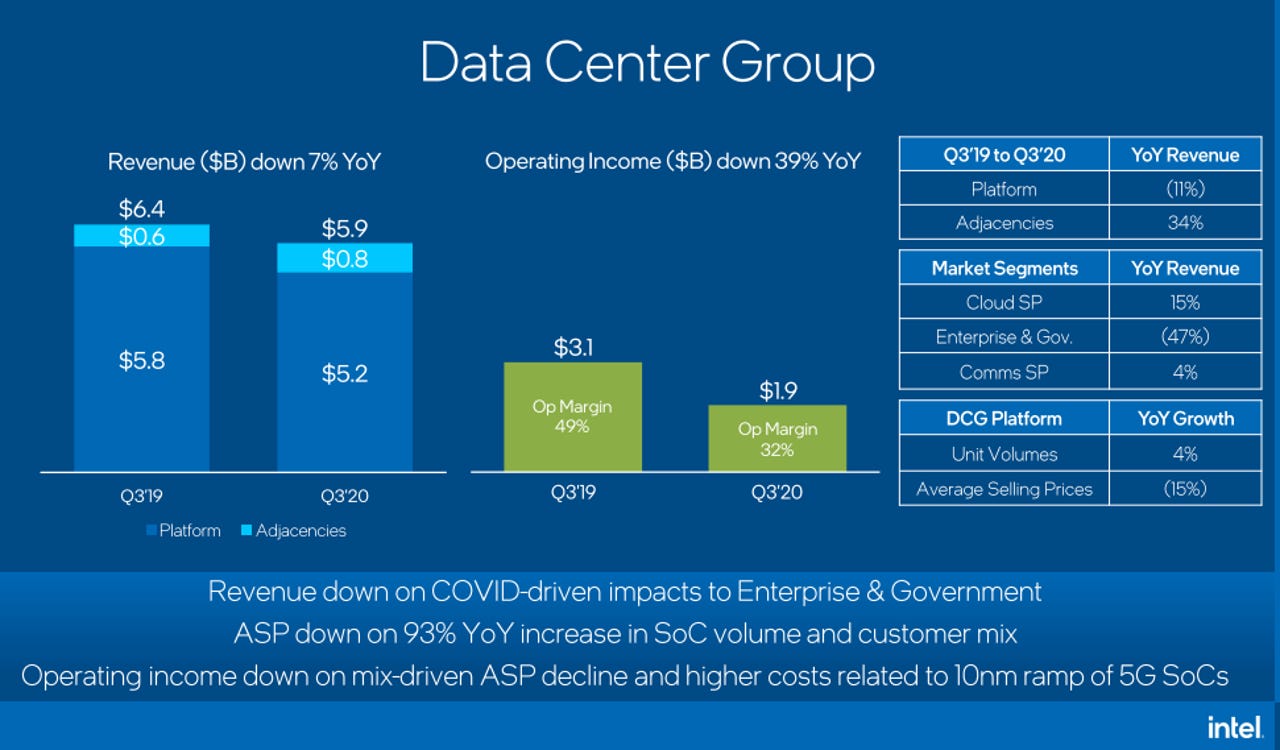Intel's Q3 in line with expectations, data center chip sales down from year ago

Intel reported third quarter results in line with expectations and raised its outlook for 2020. Cloud providers continued to buy Intel's server chips, but enterprise demand was weak.
The company recently outlined plans to sell its NAND flash memory unit to SK Hynix for $9 billion to focus on its core CPU business. Intel also launched industrial IoT processors during the quarter. The company, however, is facing stiff competition from smaller rival AMD as well as Arm-based processors and Nvidia.
Intel reported third quarter revenue of $18.3 billion, down 4% from a year ago, with earnings of $1.02 a share. Non-GAAP earnings for the third quarter were $1.11 a share. As for the outlook, Intel projected revenue growth of 5% to $75.3 billion with non-GAAP earnings of $4.90 a share.
Wall Street was expecting Intel to report third quarter revenue of $18.25 billion with non-GAAP earnings of $1.11 a share. For 2020, Intel is expected to report non-GAAP earnings of $4.85 a share to $75.2 billion.
The company said:
In the Data Center Group (DCG), Cloud revenue grew 15 percent YoY on continued demand to support vital services in a work and learn-at-home environment. At the same time, a weaker economy due to COVID-19 impacted DCG's Enterprise & Government market segment, which was down 47 percent YoY following two quarters of more than 30 percent growth. The pandemic also weighed on third-quarter data-centric results in the Internet of Things Group and the memory business (NSG).
Intel did say that the PC unit continued to see demand in the third quarter from remote work and education efforts.
In addition, Intel said its third 10nm manufacturing facility in Arizona is fully operational. The company expects to ship 30% higher 10nm product volumes in 2020 compared to January expectations.

CEO Bob Swan on a conference call talked up Intel's Evo platform, new scalable Xeons and the company's next-generation GPUs. However, Swan also said the company need to juice growth. Swan said:
We're focused on extending our reach to accelerate our growth. We are actively executing against a diversified growth strategy and now have several multibillion-dollar businesses fueled by data and the rise of artificial intelligence, 5G network transformation and the intelligent autonomous edge. We built these businesses by positioning the company to grow share in the largest market opportunity in our history in a world where everything increasingly looks like a computer. Our ambitions are much greater. And to realize them, we must play a larger role in our customers' success.
Patrick Moorhead, principal of Moor Insights & Strategy, said this was the first quarter where COVID-19 hampered Intel. Moorhead said:
Covid-19 appears to have impacted mix as PC demand shifted to lower margin education SKUs and enterprise datacenter demand looks to have dried up, replaced or weighed down by lower-margin cloud business. I do think Tiger Lake is strong for thin and light notebooks and believe it has a very good assortment coming into the holidays.
Swan also touted Intel's roadmap going forward.
As I look to the next several years of products, I'm excited about the products we have coming. We are now sampling our 2021 client CPU, Alder Lake, and we'll be sampling our 2021 data center CPU, Sapphire Rapids, later in the fourth quarter. Both will deliver significant capabilities enabled by our 6 pillars of innovation, including our enhanced SuperFin technology. We have another great lineup of products in 2022, and I'm increasingly confident in leadership our 2023 products will deliver on either Intel 7-nanometer or external foundry processes or a combination of both. I look forward to providing further update in the January call.